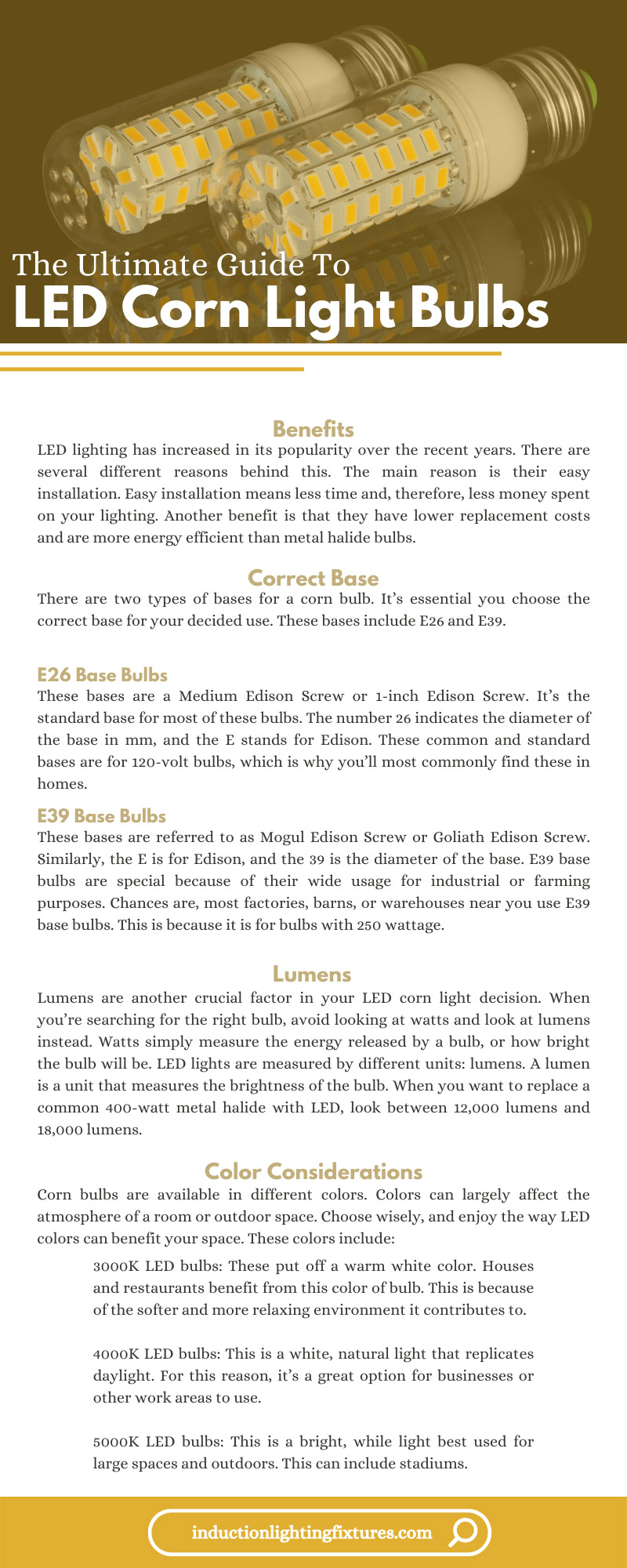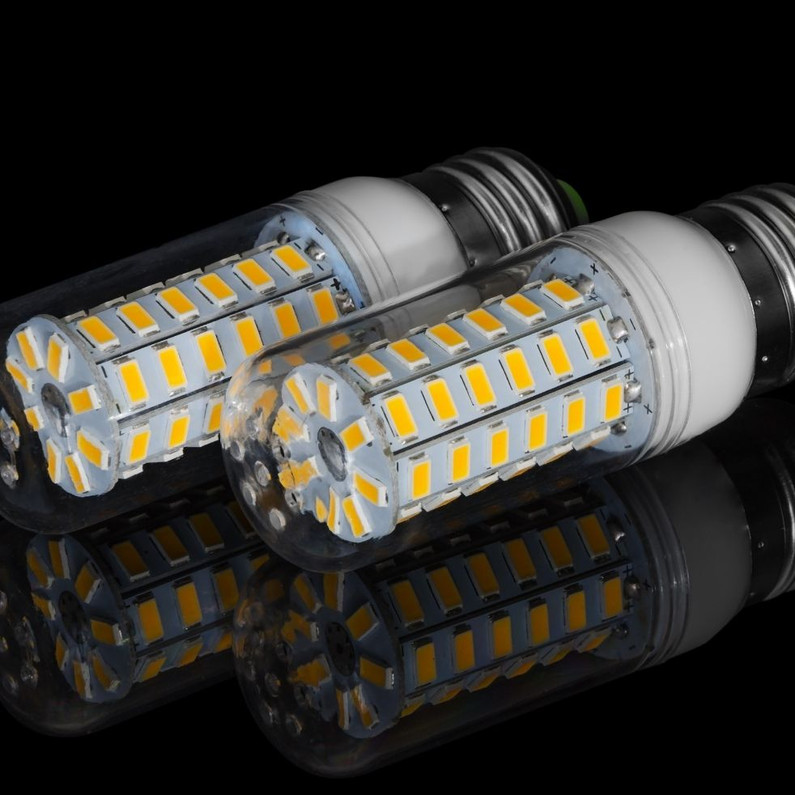The Ultimate Guide To LED Corn Light Bulbs
Have you been considering making a switch to LED corn light bulbs? If so, follow the ultimate guide to LED corn light bulbs. If these types of lights are a new concept to you, here’s a brief background. LED corn light bulbs have the name they do because of their appearance. They simply resemble corn on the cob. Lines of square light diodes are on the sides of the tube. The cob has anywhere from 80 to 108 LED lights. The numbers of these lights are dependent on the size and style of the bulb. An LED corn light is designed to replace HID lamps and traditional metal halide bulbs. You’ll most commonly find these in street lighting, stadium lighting, and parking lots.
Benefits
Let’s dive a little deeper into the benefits of LED lighting. LED lighting has increased in its popularity over the recent years. There are several different reasons behind this. The main reason is their easy installation. Easy installation means less time and, therefore, less money spent on your lighting. Another benefit is that they have lower replacement costs and are more energy efficient than metal halide bulbs. With a lifespan of 25 years, they are much easier and less expensive to use.
Correct Base
There are two types of bases for a corn bulb. It’s essential you choose the correct base for your decided use. These bases include E26 and E39.
E26 Base Bulbs
These bases are a Medium Edison Screw or 1-inch Edison Screw. It’s the standard base for most of these bulbs. The number 26 indicates the diameter of the base in mm, and the E stands for Edison. These common and standard bases are for 120-volt bulbs, which is why you’ll most commonly find these in homes.
E39 Base Bulbs
These bases are referred to as Mogul Edison Screw or Goliath Edison Screw. Similarly, the E is for Edison, and the 39 is the diameter of the base. E39 base bulbs are special because of their wide usage for industrial or farming purposes. Chances are, most factories, barns, or warehouses near you use E39 base bulbs. This is because it is for bulbs with 250 wattage.
Lumens
Lumens are another crucial factor in your LED corn light decision. When you’re searching for the right bulb, avoid looking at watts and look at lumens instead. Watts simply measure the energy released by a bulb, or how bright the bulb will be. LED lights are measured by different units: lumens. A lumen is a unit that measures the brightness of the bulb. When you want to replace a common 400-watt metal halide with LED, look between 12,000 lumens and 18,000 lumens. A few more replacement choices include:
- 250-watt metal halide: 9000 to 12,000 lumens
- 150- to 175-watt metal halide: 7000 to 9600 lumens
- 75- to 125-watt metal halide: 4000 to 8000 lumens
Color Considerations
Corn bulbs are available in different colors. Colors can largely affect the atmosphere of a room or outdoor space. Choose wisely, and enjoy the way LED colors can benefit your space. These colors include:
3000K LED bulbs: These put off a warm white color. Houses and restaurants benefit from this color of bulb. This is because of the softer and more relaxing environment it contributes to.
4000K LED bulbs: This is a white, natural light that replicates daylight. For this reason, it’s a great option for businesses or other work areas to use.
5000K LED bulbs: This is a bright, while light best used for large spaces and outdoors. This can include stadiums.
Avoid colors any higher in rating because they can be dangerous for the environment and humans as well. The American Medical Association stated that colors 5700K and 6500K’s blue light interferes with melatonin production. Therefore, it’s best to avoid them in general.
Choosing LED Corn Bulbs
There are two types of LED corn bulbs to choose from. One provides 180 degrees of light, while the other provides 360 degrees. The flat, 180-degree bulb points light downward. On the other hand, a 360-degree light provides light in all directions, which is more cost-effective. These may be the best choice for outdoor and indoor applications.
Voltage
LED corn bulbs work from 90 to 277V AC. Ensure your safety and use recommended voltages of corn bulbs: 120 volts, 208 volts, 220 volts, 240 volts, and 277 volts. Take the time to find the right fit for your specific space. With so many options, it’s worth slowing down and taking time to contemplate the decision.
Fittings
These bulbs are available in many different fitting sizes. Be sure you write down the fitting reference number so that you can have confidence in your next bulb purchase. Don’t waste your time and money by purchasing a bulb that doesn’t have the right fitting size you need. You should also consider leaving a space for cooling once you remove the old bulb.
Enclosed Fixtures
Take note that it’s a risk to use LED corn bulbs in fully enclosed fixtures. In fact, there’s a warning from some manufacturers of this. If you plan to use these in an enclosed fixture, go out of your way to make sure you found the right manufacturer. Some companies make these bulbs for use in enclosed fixtures, but you have to keep your eye out for them.
Use the ultimate guide to LED corn light bulbs before you make the switch from metal halide bulbs. Don’t let the change intimidate you. Although there’s a lot of information to consider, you can have confidence in your choice of base, lumens, color, voltage, and fixture design. In using this guide, you’ll find that confidence while saving yourself time and money before you make the purchase. If needed, print this guide out and take it with you to the store. In doing so, you won’t forget the provided information or have pressing questions along the way. Once you decide on your purchase, enjoy the many benefits of LED corn bulbs. They have everything from increased longevity to brightness to easy installation, so you won’t regret your choice.

Recent Posts
-
Spotlight - The IL-SPG54 Smart Solar Walkway Light: Where Performance Meets Simplicity
Introducing the IL-SPG54 Smart Solar Walkway Light: Where Performance Meets Simplicity When it comes …Jun 16th 2025 -
Corn Bulb Sale - While supplies last!
⚡ Limited Time Sale – BLE Series Corn Lamps Starting at $24.99! Stock up now while supplies la …Jun 11th 2025 -
Dark Sky Lighting in Breckenridge Colorado. Can I retain my existing fixture and still comply with the new Rules?
Breckenridge Colorado Dark Sky lighting has been a focus of ours for the last year. All resid …May 2nd 2025






